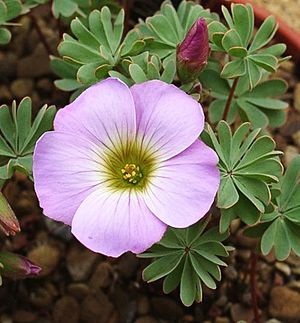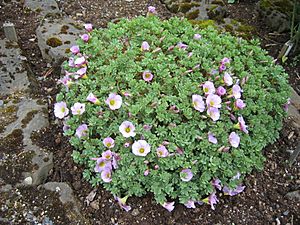Oxalis enneaphylla facts for kids
Quick facts for kids Oxalis enneaphylla |
|
|---|---|
 |
|
| Scientific classification | |
| Genus: |
Oxalis
|
| Species: |
enneaphylla
|
Oxalis enneaphylla, often called scurvy grass, is a small plant that blooms in late spring and summer. It grows from special underground stems called rhizomes. This plant is a perennial herbaceous plant, meaning it lives for more than two years and has soft, green stems. You can find it growing in the cool, high-altitude areas of Patagonia and the Falkland Islands.
This plant is quite small, usually growing about 7 cm (2.8 in) tall and 10 cm (3.9 in) wide. Its leaves are a bit thick, hairy, and have a blue-grey color. While you can eat the leaves, they have a very sharp taste. This is because they contain a lot of oxalic acid. The name enneaphylla comes from Greek words: ennea means "nine," and phyllon means "leaf."
Contents
Flowers and Pollination
The flowers of Oxalis enneaphylla have five petals and smell like almonds. They are usually pink, fading to white. These flowers have both male and female parts, which means they are hermaphrodite. Tiny creatures like Lepidoptera (which include moths and butterflies) help to pollinate these flowers. This process helps the plant make seeds.
Why is it Called Scurvy Grass?
The common name "scurvy grass" comes from a very important fact: the leaves of this plant are packed with vitamin C. This vitamin is essential for good health. However, Oxalis enneaphylla is not closely related to another plant also called scurvy-grass (Cochlearia). Also, neither of these plants are true grasses (Poaceae).
Historical Use by Sailors
Long ago, sailors traveling around the dangerous Cape Horn would eat the leaves of Oxalis enneaphylla. They did this to prevent a terrible disease called scurvy. Scurvy is caused by not getting enough vitamin C.
A man named Syms Covington sailed with Charles Darwin on the ship HMS Beagle. In his journal, he wrote about the Falkland Islands and mentioned Oxalis enneaphylla, calling it "wild thyme." Here is what he wrote:
While laying here we found it very squally, and at times very cold. The island is in general mountainous. Not a single tree to be seen but there are low brushes with red berries which are very good eating. Here are bullocks, horses and pigs that run wild, rabbits, wild geese and ducks and most excellent snipe shooting on the marshy ground and long grass, of which the island in general has very little else. Likewise there is the tea plant, which bears very sweet berry, and wild thyme which we used as tea, and is very good and much more plentiful than the former.
This shows how important this plant was for sailors to stay healthy on their long voyages.
Growing Oxalis Enneaphylla
People grow Oxalis enneaphylla in places with a temperate climate, which means not too hot and not too cold. It is a great plant for rock gardens or alpine gardens. These are special gardens designed to look like mountain environments.
Both the main plant species and a special type called 'Ione Hecker' have won an important award. This award is the Royal Horticultural Society's Award of Garden Merit. This means they are excellent plants for gardeners to grow.
See also
 In Spanish: Ojo de agua para niños
In Spanish: Ojo de agua para niños


